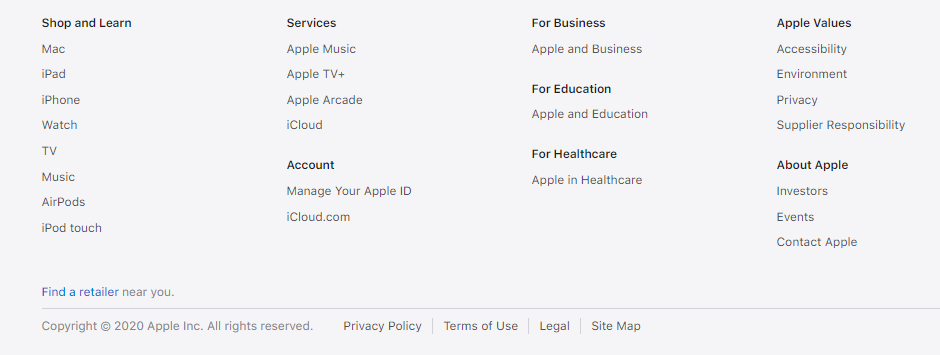In terms of Search Engine Optimization (SEO), what is sitemap? A sitemap is similar to a Google map for users and crawlers.
Visitors can know an overview of the whole website, the structure of categories and subcategories, and links for quick navigation. In the meantime, sitemap plays a vital role in instructing Google bots to crawl the website, read page content, and contribute to evaluating the website rankings.
There are 2 common types of sitemaps: HTML sitemap and XML sitemap.
In general, HTML sitemap SEO is used for users to take a look at the website, and XML sitemap is for search engine crawlers.

The XML sitemap is quite essential for SEO forever – it is a truth and a truth. But what’s about the sitemap HTML? Whether it is still beneficial for websites to reach the top ranking?
The answer stays in this article!! Keep following and share your thought with us.
What is HTML Sitemap in SEO?
Table of Contents
As mentioned above, HTML sitemap serves website users.
The HTML sitemap involves every web page on the website to creates a general picture of websites.
Let’s take a look at this sitemap HTML for more visuals:

If a website store owner generates a sitemap HTML, the user experience is much more improved because of clear navigation to explore the online store. Instead of seeking pages, customers can now find out wanted information by clicking links listed on the HTML sitemap.
Regarding SEO, the better the user experience becomes, the higher rankings your website can achieve based on Google’s evaluation. It’s an essential factor for Google to rank a website in the search engine result pages.
HTML Sitemap vs XML Sitemap
What makes HTML sitemap different from XML sitemap? And which one should be put a greater weight in terms of SEO? These questions always cause a lot of confusion for marketers and store owners when even they may not know the exact answer.

Both of them are dispensable for a website but serve different purposes. We collect every information and come up with a comparison between the two sitemaps as below:
- Aims: HTML sitemap is designed for users to navigate to wanted pages. XML sitemap is generated for search engine spiders to crawl the page content.
- Display: HTML is visible for users while XML sitemap is just enabled for search engine crawlers. Visitors cannot view the XML sitemap.
- Automatic update: HTML in sitemap cannot be automatically updated while XML sitemap can be.
Above things are some highlighted differences between HTML and XML sitemap and it is still difficult to decide which one is better. Perhaps we need more pieces of evidence from Google – which controls the sitemap effect on the SEO of websites.
Why HTML Sitemap masters?
Create a form of a structured website
Google points out that you better equip large websites with a sitemap so that users can overlook the whole site instead of trying in vain to seek.
Let’s imagine that your website is expanding year by year, and when it reaches a large size, it is not very clear for customers to explore your stores, look for products or information or make purchases.
By building an HTML sitemap, every page is included in order for users to navigate and land on the desired page in the blink of an eye.
This is another example of HTML sitemap with good website organization:

Put yourself in customers’ shoes, is it more effortless to find out any page on the website? Just move to the footer and click on the sitemap, customers have no trouble discovering the online store.
Increase the chance to be indexed by search engine crawlers
Although XML sitemap is born for search engine crawlers to index the website, HTML sitemap can be still crawled too. A video by Google Webmaster reveals that they don’t guarantee Google bots can crawl all links on the XML sitemap.
Hence, HTML sitemap now becomes a good option for crawlers to index the website.
The HTML sitemap now can also instruct the bots to overlook the entire website and follow the navigation to discover the details.
It can be said that HTML sitemap is not only useful for users but also for search engine crawlers to understand website hierarchy. Only XML sitemap may not be adequate and store owners or SEOers would rather take advantage of HTML sitemap also.

Leverage page links naturally
One of the outstanding benefits of an HTML sitemap is creating a universe of page links inside the store more naturally than ever.
HTML sitemap contributes to connecting web pages by grouping links on a map and organizing them based on the website structure.

In addition to clicking wanted links, visitors possibly see more pages listed in the sitemap. This brings a large amount of traffic for the whole website, and increases the length of a customer journey or lengthens the time on page on another hand.
Is HTML Sitemap useful for SEO?

This is one of the most controversial questions in the SEO world. Each year, we often see this question on top of the SEO discussion. Is there any correct answer? We may not know exactly and should wait for an official explanation or announcement from search engines like Google.
However, let’s take into account the opinion from Google Webmaster Trends Analyst – John Mueller:
“Is there any SEO value in HTML sitemaps? Sometimes. It can definitely make sense to have these kinds of sitemaps, which are essentially a mapping of your category and your detail pages – especially if we can’t crawl a website normally otherwise.
If you have a really complicated navigation structure, maybe if you have pages that are almost connected through search forms rather than a logical structure, then having at least one place where we can understand the structure of the site, based on links, can really help us”.
Till 2019, a video from Google Webmaster also stated again that you should put HTML sitemap in your implementation plan:
“With XML sitemap, we don’t guarantee that we crawl the pages from those, but they can help us to discover new pages. HTML sitemaps can definitely help us so you have a link to your root page and then if you have an HTML sitemap, we can crawl those links to find the rest of the pages on your site.
In addition, users like it because sometimes they want to find out what’s all the stuff going on in your site and they want to see. So if you could only implement one, somebody had a gun to your head and they were like you could only do one type of sitemap. I’d start with HTML because that’s really useful for both users and search engines”.
HTML sitemap plays a very critical role in user experience and SEO effect. If your site lacks an HTML sitemap, the SEO of the website can be harmed.
Furthermore, Google hasn’t yet given any public information about whether sitemap HTML is still useful in 2020 and ever.
Thus, let’s keep following SEO guidelines, create an HTML sitemap for SEO and generate an XML sitemap to maximize index opportunities by search engine crawlers and bring a better and better user experience.
How to optimize HTML Sitemap for SEO
You need to keep in mind that building an HTML sitemap with a vast of links may be a fundamental theory. Yet, optimizing and updating HTML sitemap should not be ignored anymore.
Proper content categorization
Users are the main subjects who read your HTML sitemap. If you structure the content in the sitemap properly, it is extremely convenient for visitors to explore the website and seek wanted pages.
Also, good content categorization matters for SEO when you can divide keyword-rich content evenly in the titles, impacting rankings on SERPs.
Keywords in description or titles
As mentioned above, keywords in the sitemap are necessary. Let’s take advantage of HTML SEO tags as meta titles and meta descriptions to include keywords.
Furthermore, a sitemap with keyword-rich content at the proper level can stand out from others and get ranking advantages. Important HTML tags for SEO like meta data tags are factors contributing to the ranking results.

A suitable position for your sitemap HTML should be on your mind first. You create it for users, and putting the sitemap in a hard-to-see place is unwise.
The footer is one of the best sections to include the sitemap link.
Your customers can easily scroll down and find it.

Keep HTML sitemap updated
Unlike XML sitemap, the HTML sitemaps cannot be automatically updated. Hence, it’s better if you can always track and update once there are any new changes on the website.
For more SEO tips, please check out this article so that you can find out the best solutions to enhance your SEO. Otherwise, consider using Seo Extension Magento 2 to replace all separate modules.
Conclusion
XML sitemap is quite significant for SEO. However, sitemap HTML becomes a necessary and sufficient condition for a website to reach the maximum SEO efficiency.
In Magento 2, you can quickly generate an XML sitemap but sitemap HTML cannot. Hence, an Magento 2 HTML Sitemap extension like from BSS Commerce is an ideal tool to create your own HTML sitemap.
>> Some article you may interesting:
- Optimize Magento SEO URLs With This Tutorial
- Hreflang Tags In SEO: 9 Common Mistakes You Should Never Make
